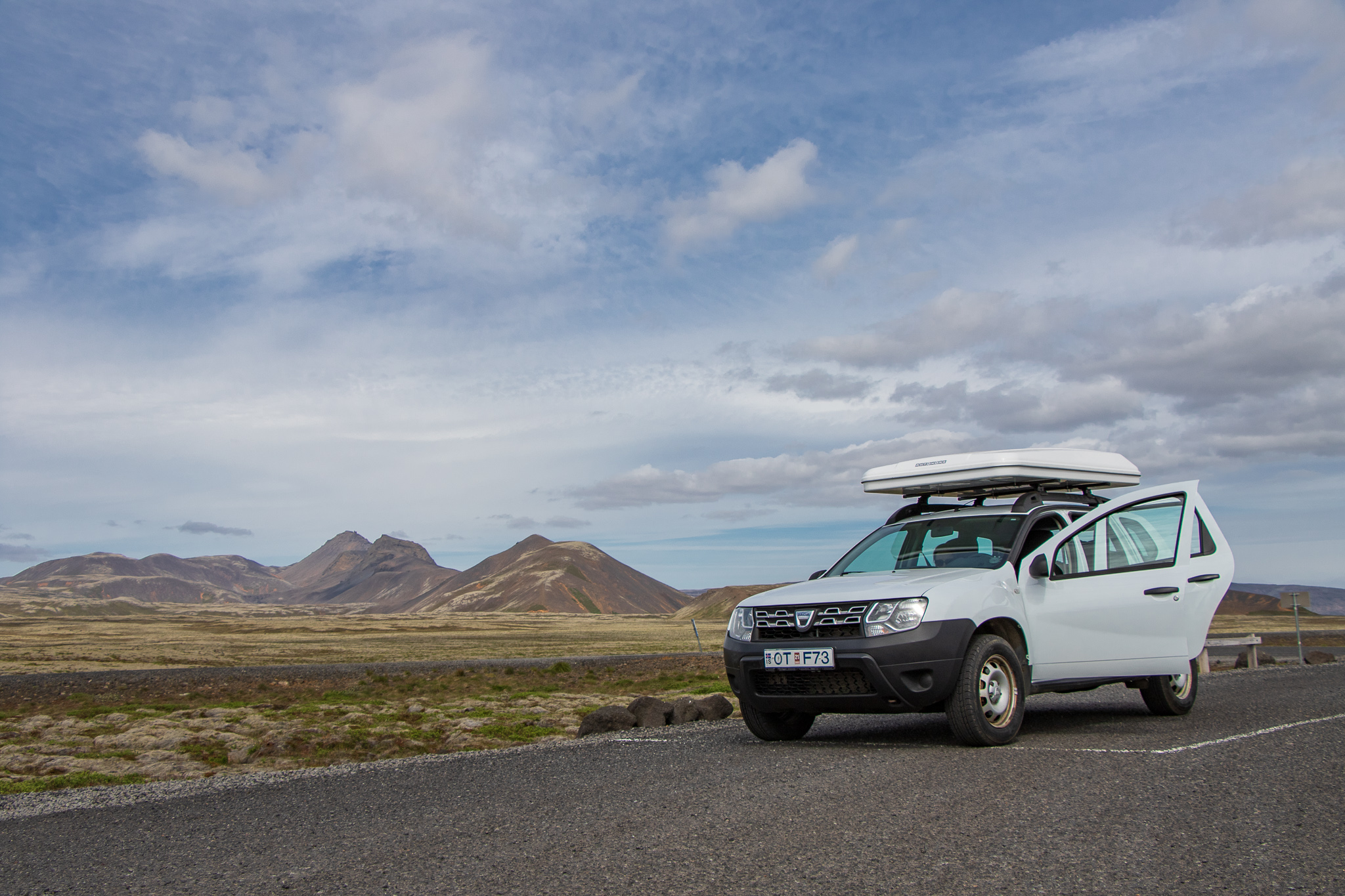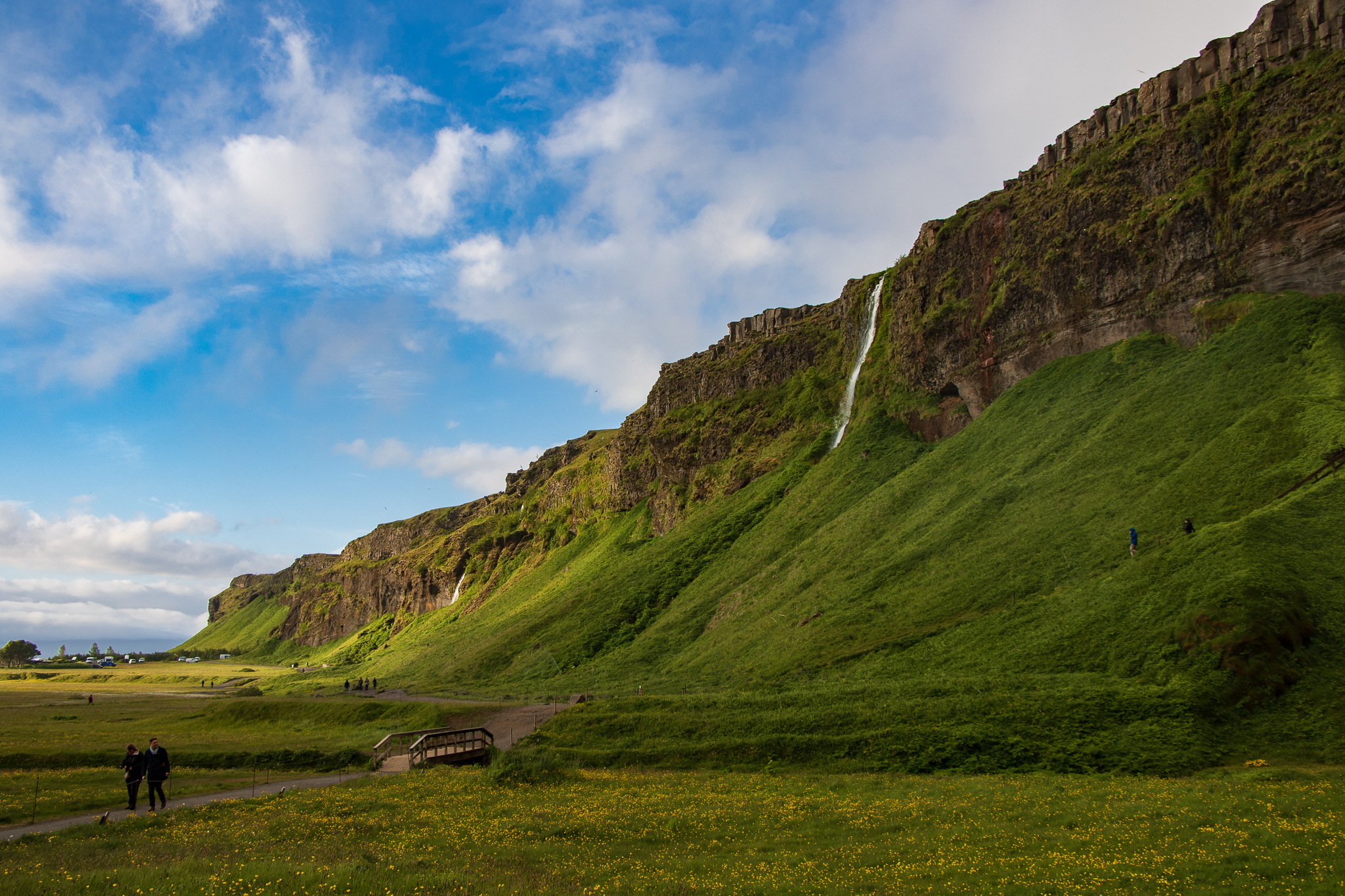Our flight left Toronto at about midnight. I had spent the whole day being anxious about packing everything properly and getting to the airport on time, but in the end we got there with hours to spare and 600 grams under weight. The flight was about 5 hours long, but we probably only slept for 3 of them. We arrived bleary-eyed at KeflavÃk airport in Iceland at about 10 am local time.
Airport security was really fast, with the only pause being when the customs officer took a moment to look at the artwork inside our passports. We'd heard that alcohol was super expensive in Iceland, so we stopped in at the duty free store on our way through. This information was backed up by signs throughout the airport reading "Why do Icelanders shop at Duty Free? Because it's cheaper, of course!" The store was laid out like a supermarket, obviously designed for high throughput.

We were met in the arrivals hall by a man from CampingCars.is, through whom we'd booked an SUV with a rooftop tent. He took us in a shuttle van back to their base, which was about 10 minutes drive away, where we hung out for another 10 minutes while another couple worked through their paperwork. Once it was our turn, I noticed that our rental document referred to our vehicle as a Dacia Duster, when I had actually booked a Suzuki Grand Vitara. We asked the manager if that was correct, and he assured us that while the car was different, it was by no means a downgrade. Apparently there had been some issue with inventory a few months earlier where they had planned to buy a bunch of second-hand Suzukis, but when they arrived they were all in bad condition and they'd cancelled the order.
After a quick walk-around and demo of the tent, we hopped in and drove down the road to a group of shops where we found a bakery and budget supermarket. Budget is a relative term in Iceland, where food costs in general are astronomical. We saw a pottle of blueberries for $23! After convincing Katie not to look at the prices, we bought some supplies for meals over the next few days. Then we hit the road!
Our first stop, about an hour away, was Þingvellir National Park (pronounced Thingvellir). Þingvellir is a World Heritage Site, and was the home of the original Viking parliament (Alþingi), back in 950 AD. The park itself is a rift valley, formed by the separation of two tectonic plates. We walked down the valley, past remains of old booths (small stone-walled buildings) and a Lutheran church, to a waterfall called Öxaráfoss. Along the way we saw lots of signs telling people to stay on the path, and not touch stuff. These signs had been planted in the middle of well tracked paths, so they were obviously new additions. We finished our walk with Icelandic ice creams from the gift shop.



Next along the road was an area called Geysir, which was a geothermal area which included many hot springs and geysers, including the Geysir geyser itself, which is the first geyser to be described in a printed source. The name means "to gush" in Icelandic, and is the source of the English word 'geyser'. We had a quick nap in the carpark (we're halfway through our second day on only 3 hours of sleep), then went for a walk through the geothermal features.

We noticed massive differences in park safety features between this area and Yellowstone (which had similar dangers). In Yellowstone there were big fences, boardwalks, and graphic signs depicting what would happen to you if you stepped off the path. Here though, there was a sign at the entrance informing you that you were here at your own risk, and then just a single rope indicating the edge of the "safe" zone. We felt that this was more to protect the natural environment, rather than the tourists.

We watched the Strokkur geyser erupt a few times, and laughed at some other people getting excited about how many times it had gone off in a row. Strokkur erupts every 8-10 minutes to a height of 20-30 metres, which is about on-par with Yellowstone's Old Faithful. We noted with a bit of embarrassment that of the largest geyers in the world, the only one we haven't seen is in New Zealand!

15 minutes further on was Gulfoss, a huge waterfall in the HvÃtá canyon. This is the northernmost point on the famous Goldern Circle route, which is very popular with tourists visiting ReykjavÃk. We sat for a while watching the river thunder down a series of steps, generating huge clouds of mist, which formed rainbows over the river.

Back on the road, we decided that we wouldn't make it all the way to our planned campsite for the night (without me falling asleep at the wheel), so Katie picked Skógar as our new destination, which was about two hours closer. On the way there we stopped at Seljalandsfoss. Although it looked from the road like just another waterfall, when we drove up to it it was actually amazing! We took a muddy path that went around behind the waterfall, where we were sheltered from the water by the massive overhanging cliff. Unfortunately it was super windy, so we still got soaked by the spray.

Finally we arrived at the Skógar Campground, which is right at the base of Skógarfoss, another great waterfall. We paid 1500 ISK each for the night (about $15 CAD each, the exchange rate is almost exactly 100:1), with an extra 300 ISK each for showers. It was a bit strange, being sunny at 10pm! After parking in the middle of a field, we popped our tent, brushed our teeth, and went to sleep.

